I’m an old Riverdale hand — before Forgotten New York was a synapse in my brain, I was stalking around the place. I recall a late November 1984 stroll in the semirural Bronx neighborhood — it was cold and it was dusk, but I’m hard up for any other details. I didn’t always have a camera with me then, to my regret. Since FNY got started in 1998, I’ve been there at least once or twice a year. Not one but two ForgottenTours have been held there (in the latest, in 2011, I bit off more than I could chew and we walked for 5 hours including a mile walk back to the subway in the rain. I have tightened up the tour routes since then). I looked at an apartment on Henry Hudson Parkway about 12 or 15 years ago and at the time a 1 bedroom would have cost $800 a month.
This one went especially well because Little Neck (my neighborhood) to Riverdale isn’t an arduous trip at all. Just the LIRR to Penn Station and the #1 train to 231st Street — it takes about an hour. On the way home I treated myself to a Metro North ride from Riverdale to GCT and a hot chocolate when I got there. I had a Metro North schedule with me and arrived just in time to catch the inbound. [My facebook pal Emily Moser rides the Metro-North extensively and blogs about it here.]
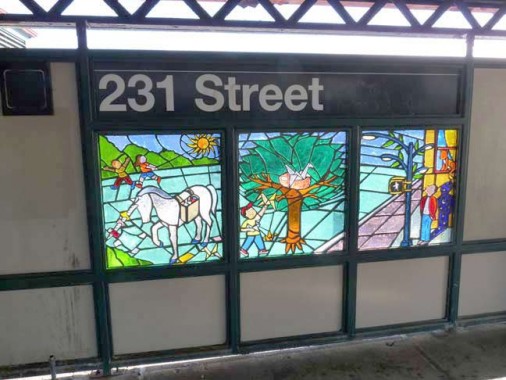
The MTA has gotten good at refurbishing elevated stations, though so far it’s dropped the ball at most of the stations on my “home” line, the #7 Flushing Line. The elusive unicorn is pictured here in Felipe Galindo’s series “Magic Realism in Kingsbridge.”
GOOGLE MAP: SPUYTEN DUYVIL — RIVERDALE
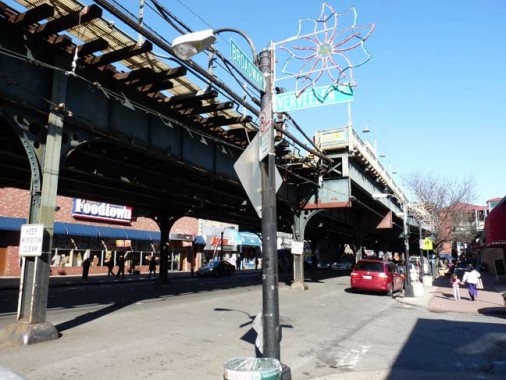
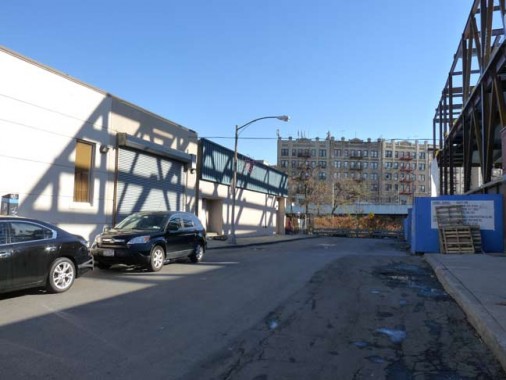
Starting briefly south on Broadway, I again encountered a favorite dead end alley, Verveelen Place, noting the dwarf lamps under the Broadway el. According o Bronx historian John McNamara, the Place commemorates Revolutionary War-era ferry operators Johannes and son Daniel Verveelen, who ferried passengers over Spuyten Duyvil Creek (since engineered into the Harlem River) and had a home and inn in the area from 1669-1693. Note the curved-mast light post — we will see more of those later.

Parrilla Latina is a steakhouse on Broadway between West 230th and 231st Streets. I wouldn’t normally feature it (I’m sure it’s a nice place) but…
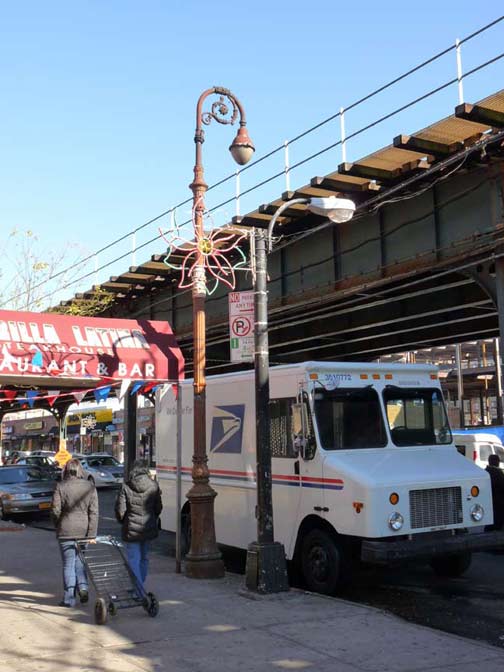
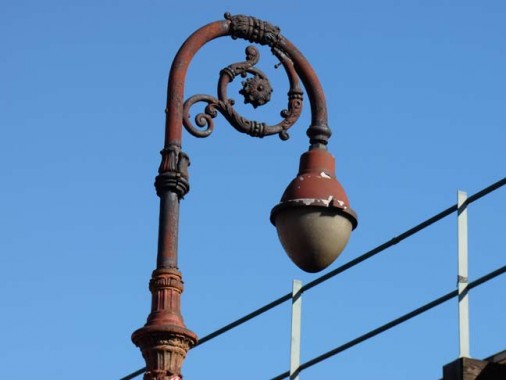
… I always pause for what’s in front of it — this 1910s vintage Type 24 BC bishop crook light post. The “cup” luminaire was added in the late 1940s, most likely, and this is the last such luminaire to have the lengthened diffuser bowl that was popular for awhile in the 1940s and 1950s. This post has the Edison Company lightbulb on its base, so it’s one of the older examples of its genre.
I doubt it lights up anymore — a newer Dwarf post has been alongside it for a few decades — but it can’t be torn down legally, as it has landmarks protection. However, a Type G post at Mosholu and Post Avenues about a mile to the north finally rusted so much that the city finally replaced it, despite its Landmarks status.
Landmarks status should force the Department of Transportation to maintain such properties in workable shape. Already, this post shows signs of severe deterioration.
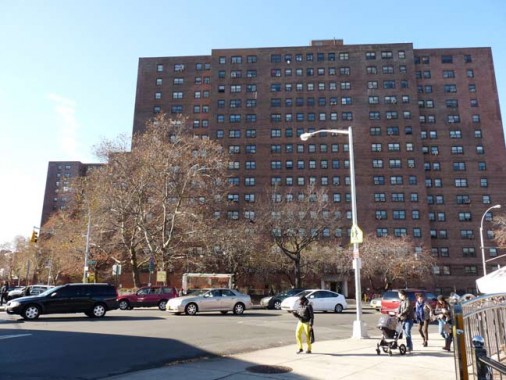
The Marble Hill Houses, Broadway between West 228th and West 230th Streets. These houses are officially in the Borough of Manhattan, as the Bronx-Manhattan borough line runs just south of West 230th. The neighborhood of Marble Hill has always officially been in Manhattan, and Spuyten Duyvil Creek used to form the border. To aid shipping it was dredged and rerouted to become part of the Harlem River emptying into the Hudson, and for awhile Marble Hill found itself on its own island. In 1916, it gained a landfill connection to the mainland, but politically, Marble Hill has still never left Manhattan. The only other land-based borough borderline is the lengthy one between Brooklyn and Queens.
These projects are pretty much the drab Corbusian towers in a park concept, but once of the buildings that faces Broadway has a surprise:

The story of Kingsbridge can be found on a grime-encrusted plaque on one of the Marble Hill Houses, on Broadway just south of West 230th Street. The plaque is devilishly hard to read, since it’s out of range of sight from the street; you have to climb the short fence or walk around it. The plaque reads:
“Northwest of this tablet within a distance of 100 feet stood the original Kings Bridge and its successors from 1693 until 1913 when Spuyten Duyvil Creek was filled up.
“Over it marched the troops of both armies during the American Revolution and its possession controlled the land approach to New York City.
“General George Washington rested at Kings Bridge the night of June 26, 1776 while en route from Philadelphia to Cambridge to assume command of the Continental Army.
“This tablet was erected by the Empire State Society Sons of the American Revolution, June 27, 1914.”
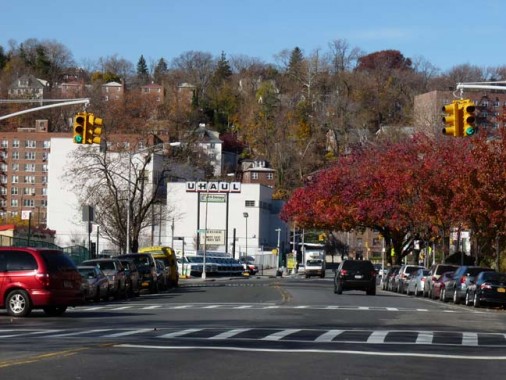
West 230th Street is a main artery between Kingsbridge (where I got off the train) and Riverdale. The hills in the distance represent the heart of Spuyten Duyvil and Riverdale, where I was bound. 230th is lined with massive apartment buildings and car washes, but there are a couple of kernels of interest that can be seen from the road.
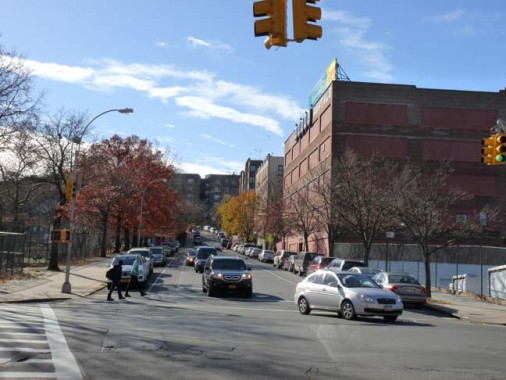
Kingsbridge Avenue and West 230th Street. Just south of here, the avenue changes its name, becoming Marble Hill Avenue. This is approximate to the spot where the original Kings Bridge crossed Spuyten Duyvil Creek.
Frederick Philipse built the first Kings Bridge, a tolled span over Spuyten Duyvil Creek, in 1693. Benjamin Palmer and Jacob Dyckman built a second bridge in 1759 to avoid paying the high tolls charged by Philipse. During his retreat from the Battle of Harlem Heights in 1776, General George Washington used both the King’s Bridge and Palmer and Dyckman’s free bridge to escape to White Plains. The original Kings Bridge has inspired a network of roads in Manhattan and the Bronx, some surviving, some not, named for it. The span survived till the excavations for the Harlem Ship Canal between 1913 and 1916, though the Bronx Historical Society supposedly maintains a small piece of it under Marble Hill Avenue between West 228th and West 230th Streets, in almost exactly its old position.
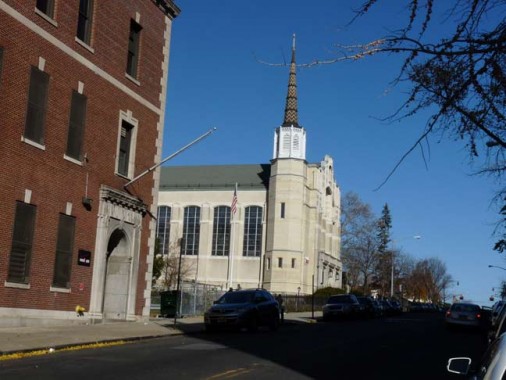
The distinctive Deco-ish spire of St. John’s Catholic Church dominates Kingsbridge Avenue north of West 1230th. The Tudor-ish church was built between 1904-1910 for the parish, which has been in existence since 1877.
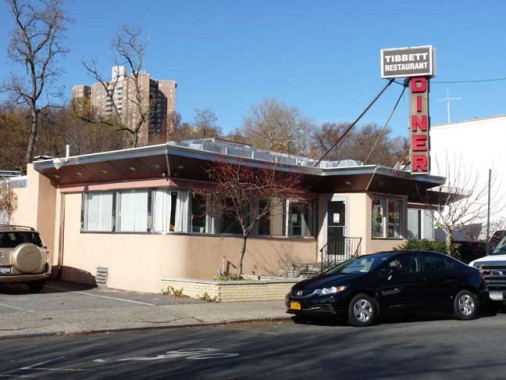
Tibbett Avenue is named for Tibbett Brook, which was shunted underground into the sewer system decades ago. Colonial-era landowner George Tippett acquired land in the area in 1668. The Tibbett Diner, on the avenue between West 230th and West 231st, was constructed in 1955 by Mountain View and redone in 1961 by DiRaffele. It survived a fire in the early 2000s.
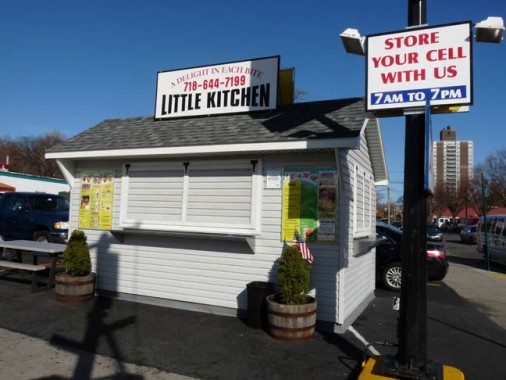
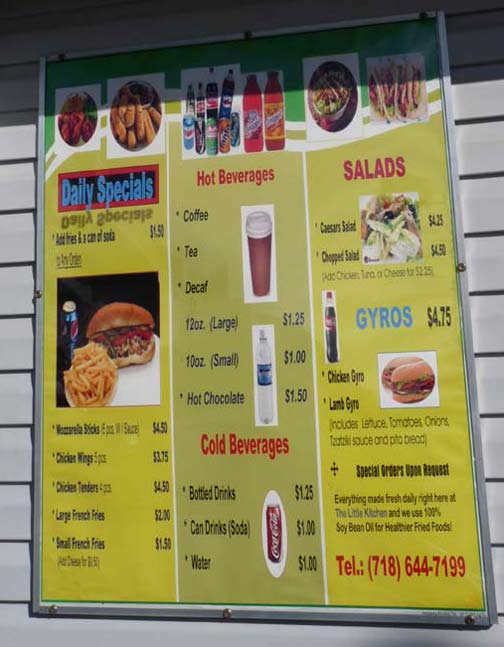
The Little Kitchen, in a picturesque mini-dwelling with a menu featuring basic fare like wraps, salads and sandwiches, serves the car wash and auto body shop workers on West 230th. And me, if it was open on the weekends.
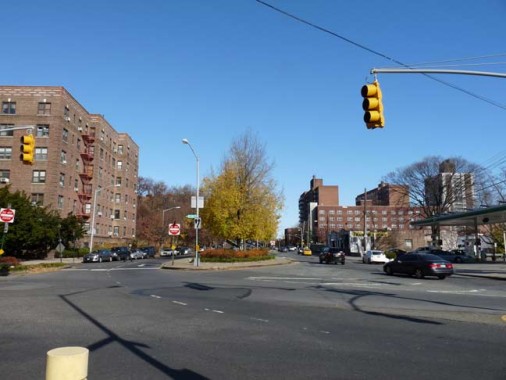
At the west end of West 230th (where the high ground interrupts it temporarily) Riverdale Avenue begins its march north to Westchester County. FNY did a page on its wonders a couple of years ago, which include the Riverdale Bell Tower, several picturesque houses and hidden alleys not depicted on maps.
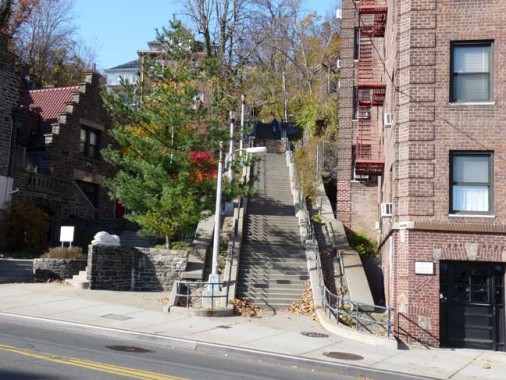
West 230th between Riverdale and Netherland Avenues takes the prize as longest step street in the Bronx and probably New York City. Spuyten Duyvilers ascending these steps after leaving the IRT at 231st and Broadway certainly keep their heart rate up when they travel these stairs every day. The staircase is four blocks long and connects Riverdale, Johnson, Edgehill and Netherland Avenues.
Kingsbridge Heights and Spuyuten Duyvil are so hilly that many step streets are necessary so pedestrians can walk in safety. West 230th is just one of many…there are Godwin and Naples Terraces, Summit Place between Bailey and Heath, at Cannon Place and Orloff Avenue at West 238th Street, and many other western Bronx spots. As an added fillip, some of these step streets preserve one-of-a-kind lamppost shaft designs. The Bronx and upper Manhattan can rival Pittsburgh and San Francisco in stepped streets, perhaps not in quantity but in quality.
In fact, West 230th is stepped again east of here, with another steep hill between Heath Avenue and Kingsbridge Terrace.
Before ascending, though, I noted this building on #1 Riverdale…
The residential complex collectively known as #1 Riverdale is houses in a series of Flemish-style brick buildings with he stepped cornices seen frequently in representations of Oude Dutch Nieuw York. I like what they did with the carved concrete lions –each has a different expression.

Here’s a detailed street/property map from the early 1900s of the area into which we’re ascending via this staircase. I’ve helpfully added street names where they’re missing from the sample, and outlined the staircase in red. Both the Edgehill Inn (built on the site of Revolutionary War era fort) and Nipinichsen Club, named for a Weekwaeskeek Indian village that was here long before the colonial era, are long gone.
The staircase connects four avenues and runs for 3 complete blocks.
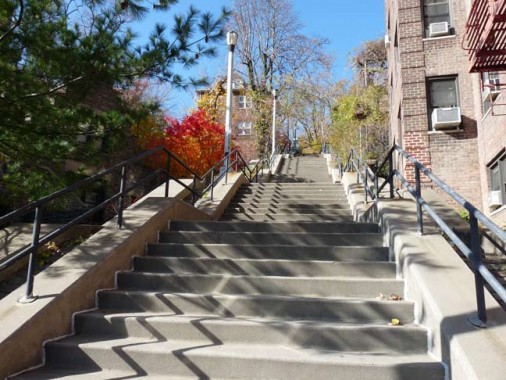
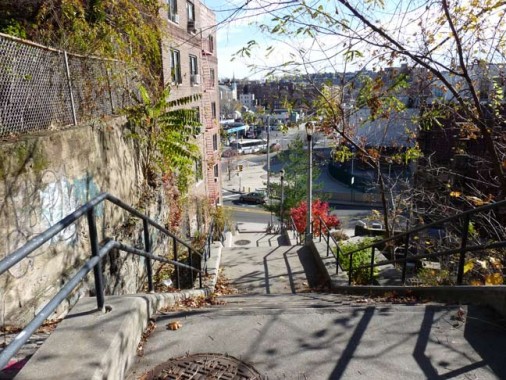
West 230th, looking north and south, just north of Riverdale Avenue.
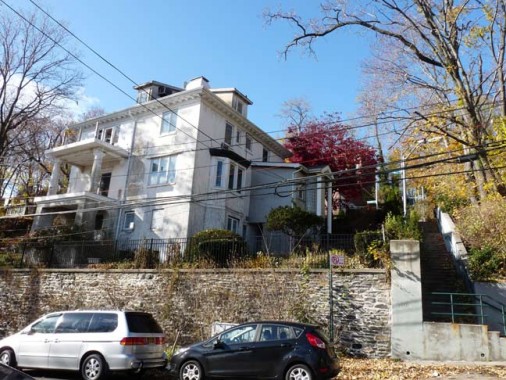
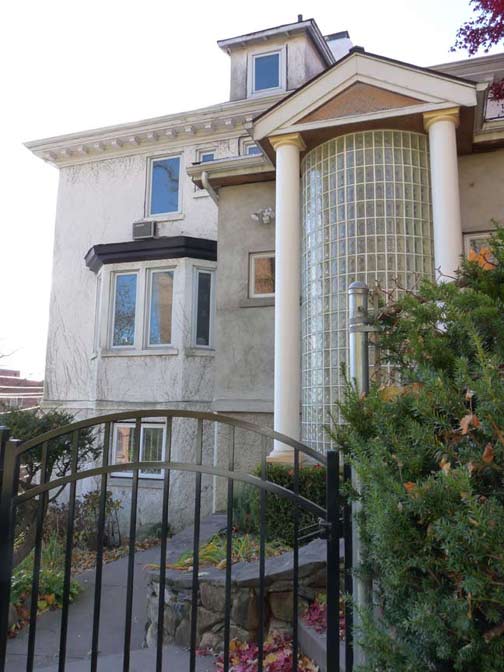
The first “landing” is on Johnson Avenue. A near-palatial mansion entered from Johnson also has a side entrance on the steps. The avenue is named for Isaac Gale Johnson, who owned an iron foundry and manufactured munitions for the Union side during the Civil War. Five mansions belonging to the Johnson family were built during the postwar era, but all had been razed by 1938.
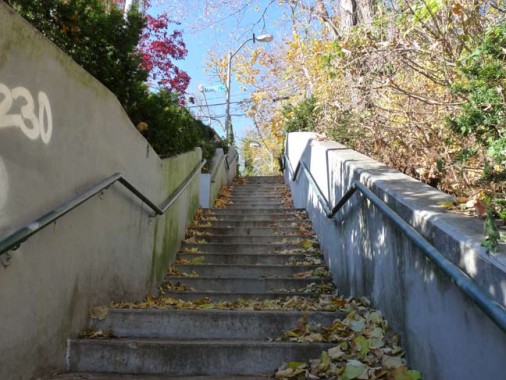
Continuing up a short stretch of steps…
You alight at the northern dead end of Edgehill Avenue, which is shaped like a reverse J, connecting to Netherland Avenue one block to the west. We are nearing the crest of Tippett’s Hill (see Tibbett Avenue above) and the site of the fort. The avenue is dominated by cottage-like one family houses.
Ascending again up the final leg of staircase between Edgehill and Netherland Avenues. Along the way there are one or two homes that actually are entered via the staircase, which is officially West 230th Street.
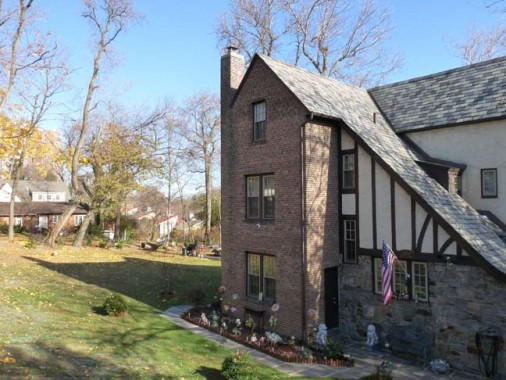
The massive Tudor at he top of the steps at Netherland Avenue has an incredibly spacious back yard. You see a lot of expansive properties here, some of which is taken up in front or back yards.
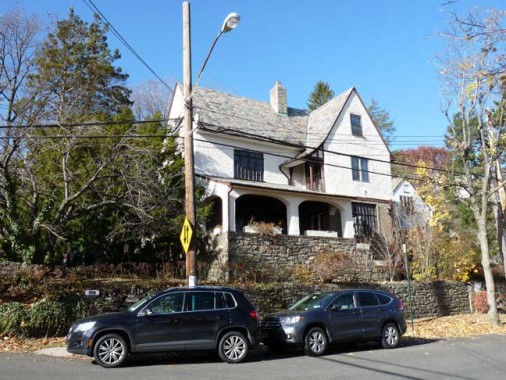

Netherland Avenue is one of those north-south Riverdale Avenues that run intermittently, skipping several streets then picking up again. Officially it runs from Kappock Street near the Harlem River to West 261st near Mount Saint Vincents, but it does so in several pieces.
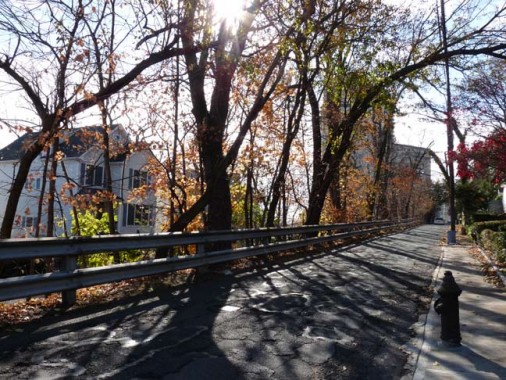
If you look at the old map above, it shows detail that modern maps don’t show, such as this mall down the center of Netherland Avenue. The section off to the left connects to Edgehill Avenue. Most maps were inaccurate regarding Riverdale until fairly recently — it has always been a semiexclusive area and before the satellite map age, researchers just didn’t have complete information and mapmakers largely had to guess and estimate.

Spuyten Duyvil has some deep bedrock, which allowed architects to build some massive apartment buildings, like the Century, 2600 Netherland Avenue, constructed in 1976.
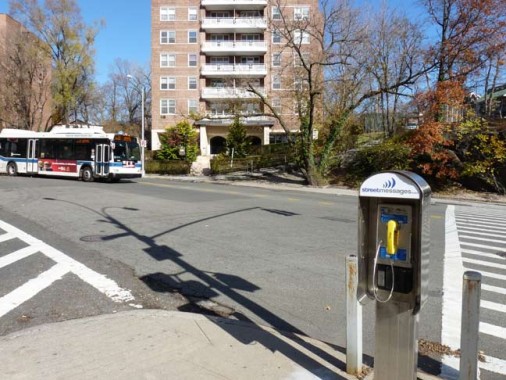
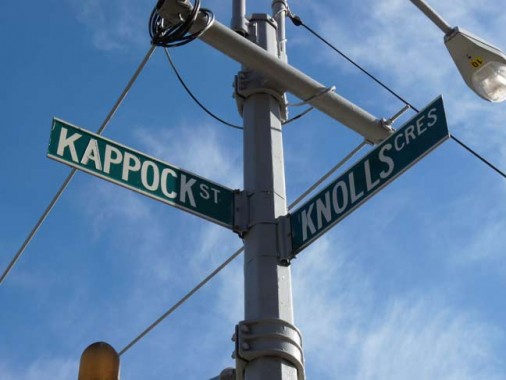
Kappock Street twists and turns in southern Spuyten Duyvil on either side of the Henry Hudson Parkway. Like Cortelyou and Schermerhorn, it’s another one of NYC streets whose pronunciation makes no sense. Local denizens say KAY-pock while to me, the double P should shorten the consonant before it into CAP-puck.
The street name was suggested by historian Thomas Edsall after it was briefly Warren Avenue after it was laid out in 1895. Kappock is a shortening of the Native American (Algonquian) Shorakkappock, meaning “Sitting Down Place.” Edsall himself has a picturesque street in Spuyten Duyvil named for him.
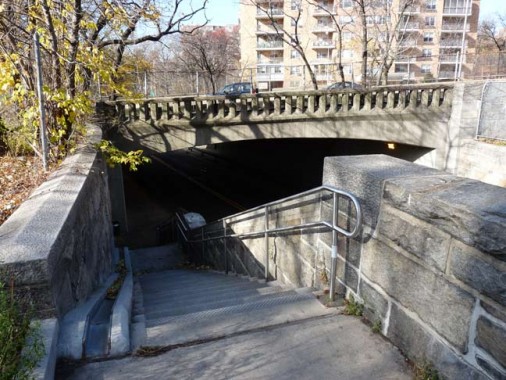
Pedestrians need to use this staircase and underpass to take Kappock Street under the Henry Hudson Parkway.
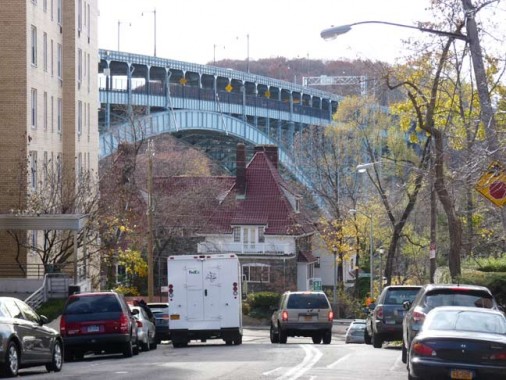

Kappock Street leads to Independence Avenue, whose name is an error: Accoding to historian McNamara, a Revolutionary War era British cartographer thought Fort Independence was located in the Spuyten Duyvil-Riverdale area instead of further east in Kingsbridge Heights. When realtors developed the area they perpetuated this error an d called one of the north-south streets Independence Avenue and perpetuated the error. Like its parallel streets, Independence Avenue runs almost all the way to Yonkers (it was fittingly called Yonkers Avenue at one point) but requires maddening detours as you proceed north.
Looking south on Independence from Kappock, you have a view of the Henry Hudson Bridge, which spans the Harlem River and carries the Henry Hudson Parkway, which has recently switched to Triboro Bridge-style lampposts.
The AIA Guide to New York describes Edgehill Church, a NYC Landmark, as having “a base of Richardsonian Romanesque, a top of Gothic Revival and a smattering of Tudor details.” Surprisingly it was designed by Francis Kimball to be a modest chapel for workers of the now-vanished Johnson Iron Foundry. Kimball also designed the brownstone Corbin Building at Broadway and John Street, now slated to remain as part of the planned new Fulton Street Transit Hub due to open late in the 2000s. Note especially the stained glass windows: they are by Louis Comfort Tiffany.
Isaac Gale Johnson, referenced above, was an original Spuyten Duyviler, founding a Civil-War era foundry supplying ordinance to the Union side. By 1890, the Johnson family owned much of what is now Spuyten Duyvil, but by 1923 they had closed and by 1938 the factory buildings had been razed.
The present location is in fact the second for the chapel. Its smaller first home of 1869 was at the present intersection of Johnson Avenue and Kappock Street, which marked the head of a no-longer-extant downhill lane known as Puddler’s Row. A “puddler” was a worker whose dangerous job involved managing molten iron as it was prepared for casting. It was the families of such employees at the Johnson Iron Works who were the focus of the mission’s work. The sprawling foundry, with smokestacks and night-reddening furnaces, occupied a peninsula reaching into the river from the base of Spuyten Duyvil cliff, just east of the shadow of today’s Henry Hudson Bridge. Lehman College
Henry Hudson Park and Monument
The spirit of Henry Hudson, it seems, seeps through Spuyten Duyvil, though the British navigator and explorer (1570-1611) apparently spent little time here when the Half Moon cruised by the region in 1609. Searching for a passage to the Pacific Ocean, Hudson wrote vividly in his log about the river that would bear his name. Hudson observed the islands that would be home to New York City, and in 1611, did find a northern passage to the Pacific when he sailed to Hudson Bay in Canada, but with disastrous consequences. His crew, Britons and Dutchmen, brawled ferociously and when they found themselves low on supplies on the frozen bay, they mutinied, setting Hudson, his son, and seven loyal crewmen adrift. Hudson presumably froze to death, while the crew starved or were killed in battles with the Inuit.
In Henry Hudson Park, at Kappock Street and Independence Avenue, you will find Karl Bitter and Karl Gruppe’s 1939 memorial, a 16-foot statue of the explorer mounted on a 100-foot shaft (that had been erected 30 years previously, on the 300th anniversary of Hudson’s visit here). Hudson and his son are shown preparing for the journey and bartering with local Native Americans in bronze reliefs on the base.
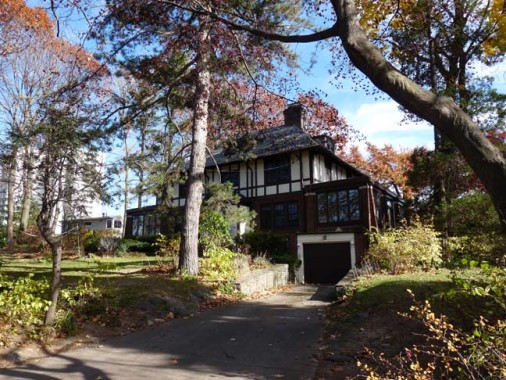
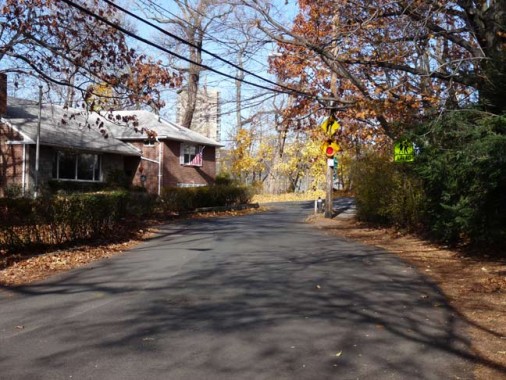
Independence Avenue, a busy 2 lane street with a double yellow line south of West 231st, narrows considerably north of there and loses its sidewalks. Riverdale was developed in fits and starts and some avenues, such as Independence, were given makeovers in some spots. Tudors abound.
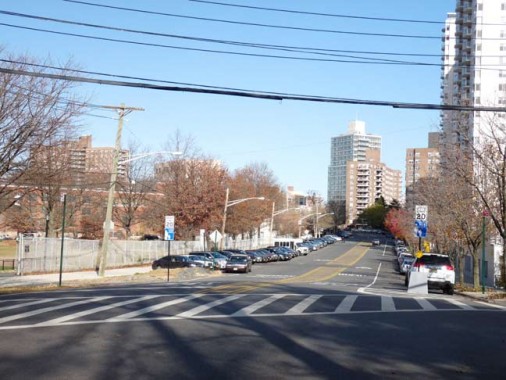
A considerably wider Independence Avenue again opens up north of west 232nd.
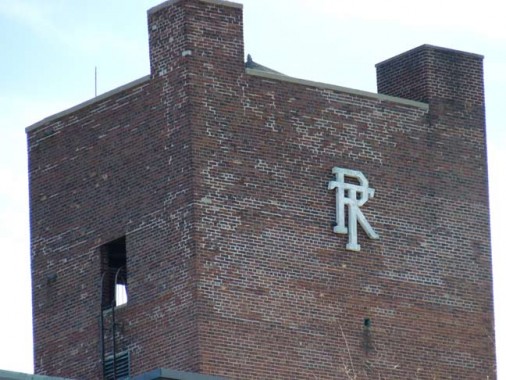
Crossing Henry Hudson Parkway at West 232nd, at the roof of an apartment building facing Fairfield Avenue, there are the initials TR. Probably the Theodore Roosevelt Apartments at one point.
(I’m told it’s Riverdale Towers… see Comments)
The corner of Fairfield Avenue and West 232nd is one of my favorites in Riverdale. It’s the only corner, perhaps in NYC, where there are not one but two early 1950s-vintage curved-mast poles, with the original masts. You can see the rust definitely poking through one these two poles. While there are other poles of similar age in Riverdale, most have received cobra-neck masts in the ensuing years. “Octagonal” poles, named for their 8-sided shafts, first appeared in 1950 and they remain NYC’s “go-to” lamppost of choice of the Department of Transportation, though curved masts with brackets like these were likely not produced anymore by 1955.
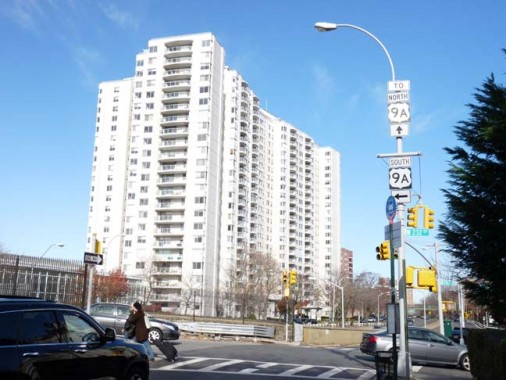
Another humongous apartment building, the appropriately-named Whitehall, dominates the Henry Hudson Parkway between West 232nd and West 235th Streets.
A pedestrian overpass at the Henry Hudson Parkway and West 236th Street preserves some mini-versions of the “Whitestone” posts, which dominated the NYC parkway and expressway scene between about 1940 and 1964, when they were largely replaced by Donald Deskey posts on the parkways. One of them is so laden with stoplights and pedestrian signals you’d think it might tip over.
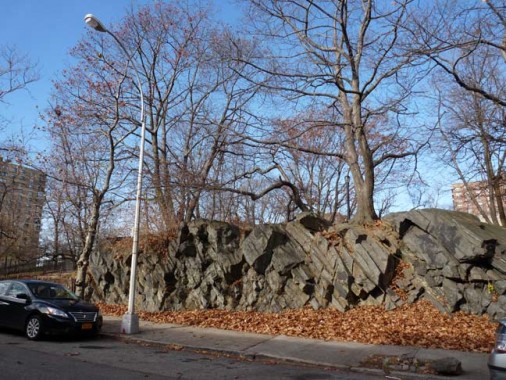
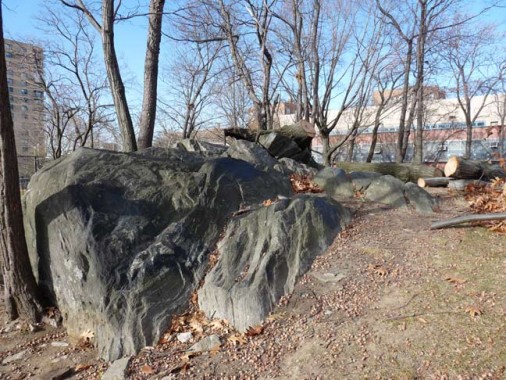
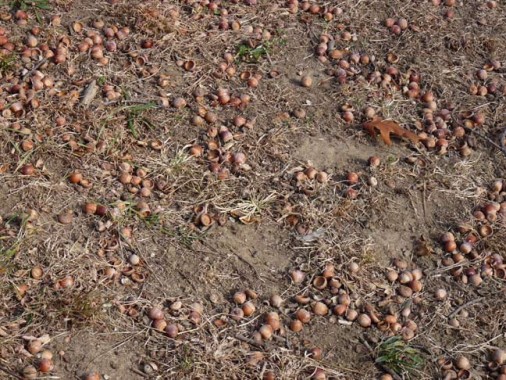
The gneiss is nice on West 246th Street and Hudson Manor Terrace at Riverdale Playground, which becomes a squirrel’s paradise in the fall. The outcroppings were left by a retreating glacier about 17,000 years ago.
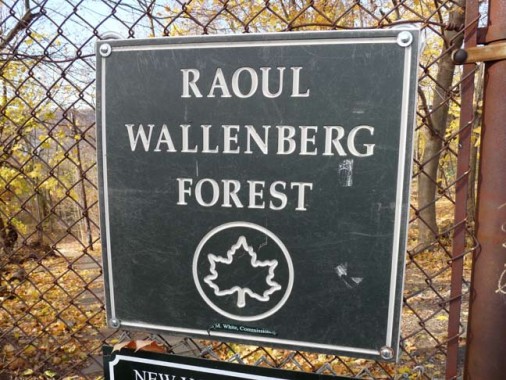
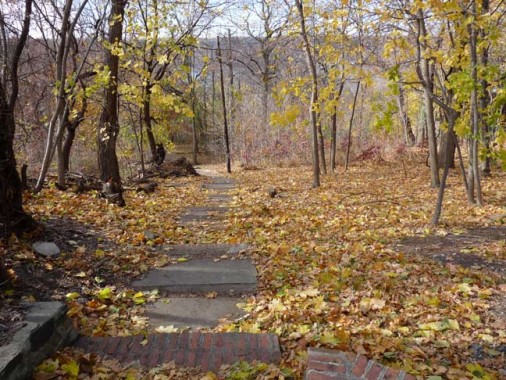
Raoul Wallenberg Forest, between Palisade and Douglas Avenues across from West 246th, is named for the Swedish diplomat (1912-1947) credited with saving tens of thousands of Hungarian Jews from extermination by the Nazis in the World War II years by designing counterfeit passports and distributing them to Jews bound for the concentration camps. He also purchased as many houses, villas, and buildings as possible and adorned them with the blue and yellow of Sweden’s flag, thereby making them neutral diplomatic property and a safe haven for Jews.
His whereabouts became unknown in 1945. In 1957, documents were released stating he had died of a heart attack in 1947 in a Russian prison. Suspicions remain that he was killed by the KGB.
The forest was part of the 1890 James Douglas estate; a later resident was U Thant, UN Secretary-General in the late 60s and early 70s. It was converted to a public park in 1990. The thickly-wooded park is home to a European beech with a 52″ diameter trunk, as well as other large, venerable trees. There are also remnants of former mansions scattered about.
Source: www.nycgovparks.com
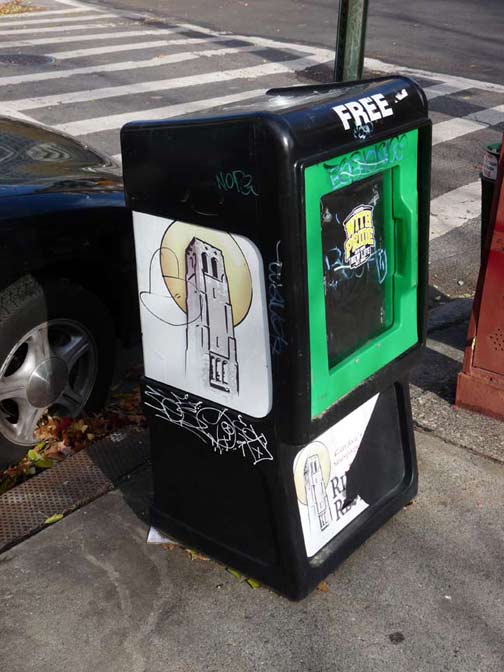
I didn’t go by the Riverdale Bell Tower on this walk, but it’s nonetheless one of my favorite area artifacts. (It’s on FNY’s Riverdale Avenue page). It is represented on newspaper boxes.
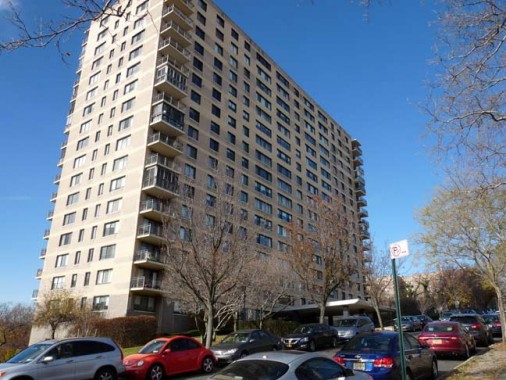
Yet another massive apartment house, the Manor Tower, dominates Hudson Manor Terrace. In an area that parsimoniously doles out Hudson River views (blocked by private property and railroad tracks) the views are available for the price of an apartment or rent, on the west side of these buildings.

Now and then, though, an opening vouchsafes a sight to behold.
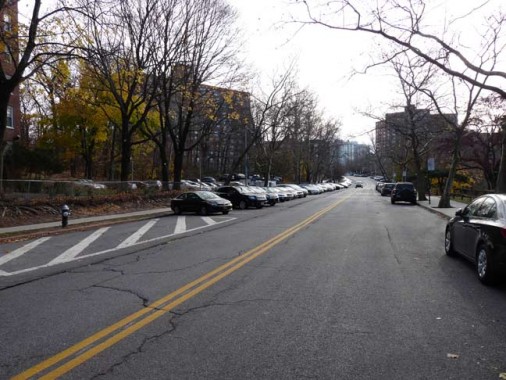
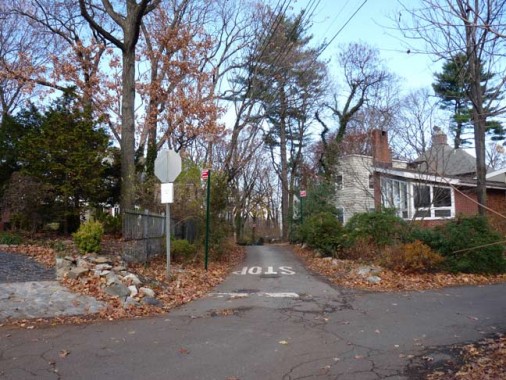
Probably the most striking tableau depicting Independence Avenue’s ever shifting role in Riverdale comes at West 246th street, where it transforms from a major two-lane boulevard (top) to a sidewalk- and shoulder-free trickle through a former private estate (bottom).
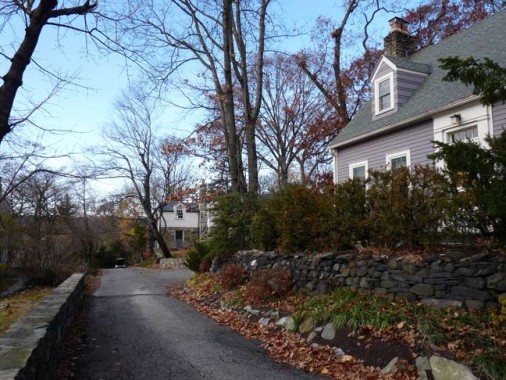
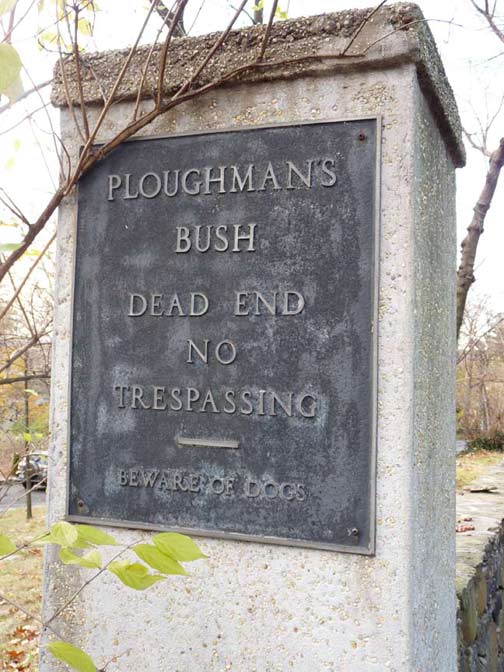
Most of my maps disagree on exactly where Ploughman’s Bush is. Google Maps and the latest Hagstrom have it emanating from Independence Avenue and West 246th trailing off northeast, which is where I found it; Google also has it connecting with the driveways around the Dodge Mansion (see below).
The city doesn’t grace it with a street sign, but it does have this iron plaque on a gatepost. I didn’t test the ‘no trespassing’ warning, fearing being met by rabid guard dogs. According to McNamara, when Robert m. Field subdivided his Riverdale properties and built houses here in 1930, he gave it this fanciful name.
A sampler of the homes found along the narrow stretch of Independence Avenue between West 246th and 247th Streets.
Dodgewood Road is one of those semiprivate streets that the Department of Transportation does not deign to mark with a street sign. The street accepts all traffic between Independence and Arlington Avenues, so I question the DOT’s philosophy here. (Near my home in Little Neck, a road goes by three names since the DOT, considering it semi-private, chooses not to mark all but the westernmost section). A private sign has been posted.
At its junction with Arlington Avenue, another massive Tudor bruits its way above the mist and falling leaves.
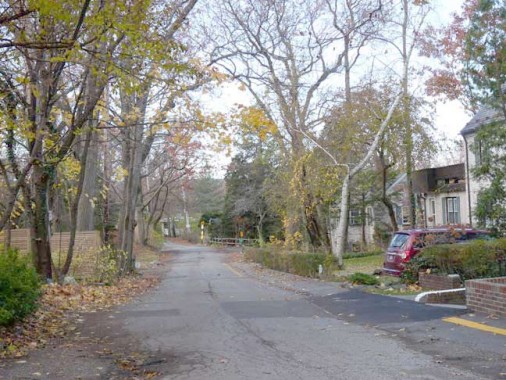
I turned west at Arlington Avenue onto West 247th Street, a near-rural country lane sans sidewalks. It’s hard to believe it but West 247th belongs to the same street nomenclature, the same “family” of streets that the bustling 14th, 23rd, 34th, 42nd, 125th and so on belong to.
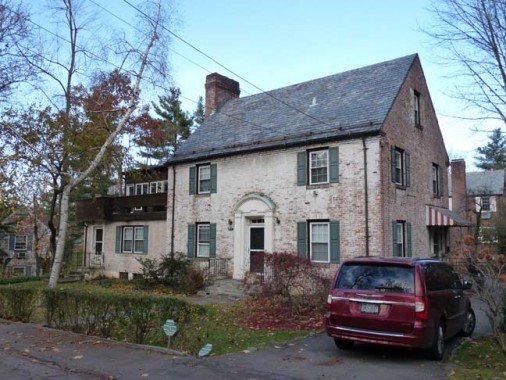
A housing development known as Alderbrook (a real stream; see below) consists of several brick houses that look like the ones the three little pigs cowered in, the big bad wolf couldn’t blow down.
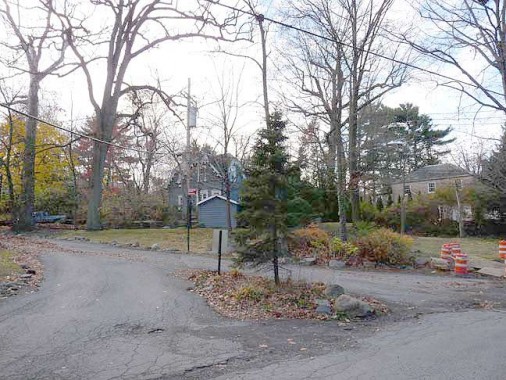
Independence Avenue comes to a temporary end at West 247th in a traffic triangle punctuated by a lone conifer.
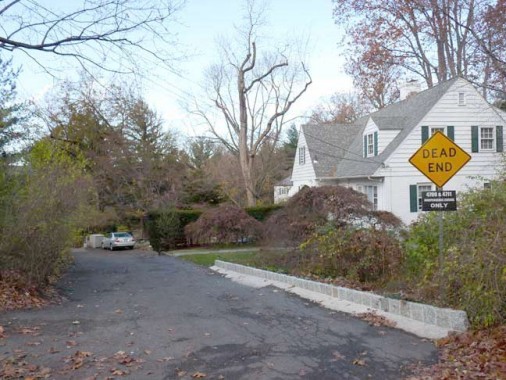
…though Independence Avenue does trail off to a dead end home to two buildings.
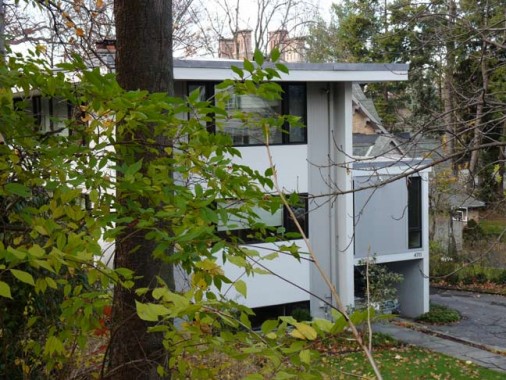
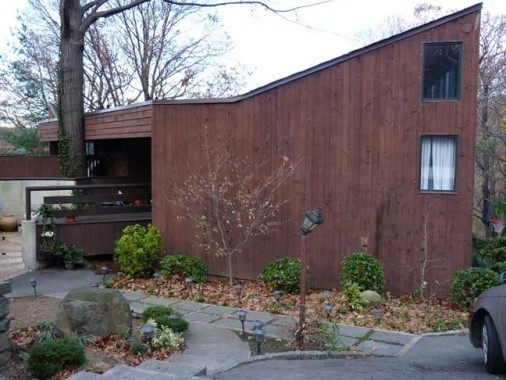
For all its historic homes, Riverdale is also dotted by Modernist-style homes built after 1960 or so. The woodframe home on the bottom is found frequently in suburbia; the style originated around 1970. You’ll be surprised to read that I don’t mind the style, except for the smallish windows. A street named Ladd Road, further north on Palisade Avenue, has several homes built in similar styles; unfortunately I didn’t get there on this walk.
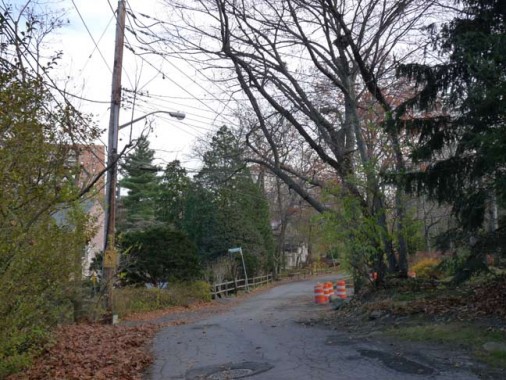
Looking west on West 247th toward Independence Avenue.
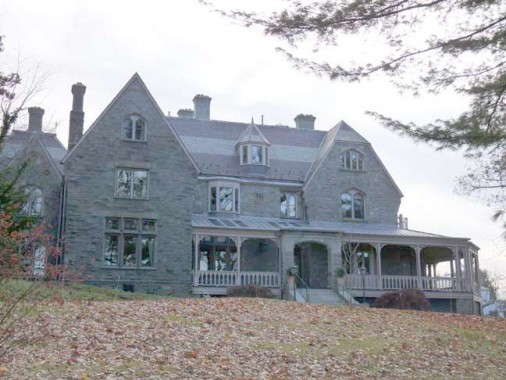
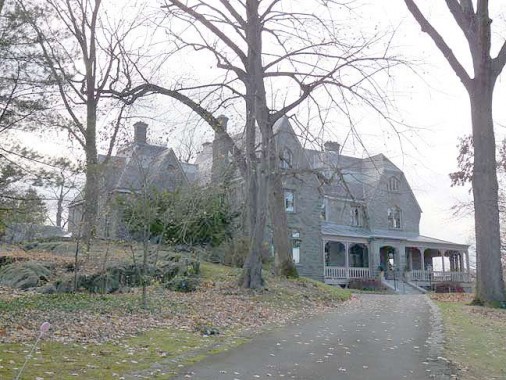
The magnificent mansion at 690 West 247th Street was built in 1863-1864 by architect James Renwick, Jr. for industrialist William E. Phelps Dodge, founder of the Phelps Dodge mining company. The Dodge family also helped found Columbia University Teachers College in 1887 and Dodge’s descendants gifted the mansion to the college in 1961. It has since reverted to a private residence after a stint as a Buddhist retreat.
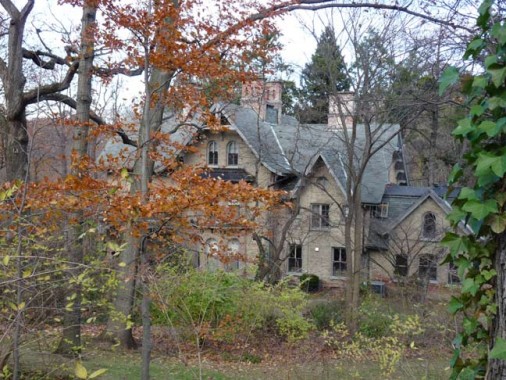
Are we in Riverdale, or Rivendell? A fanciful storybook-style mansion can be seen through the foliage on West 247th.
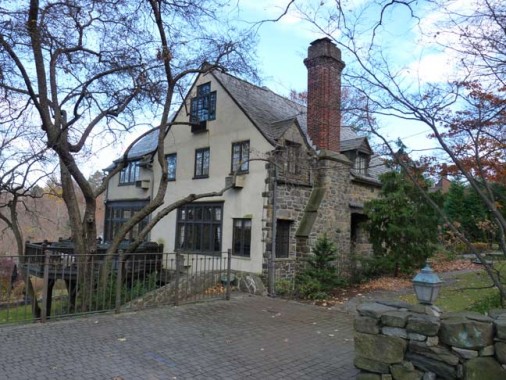
A neat Tudor complete with stone chimney across the road form the Dodge mansion. No doubt there’s a fireplace inside, and no doubt it was blazing the next day after this walk when the temperature didn’t crack freezing.

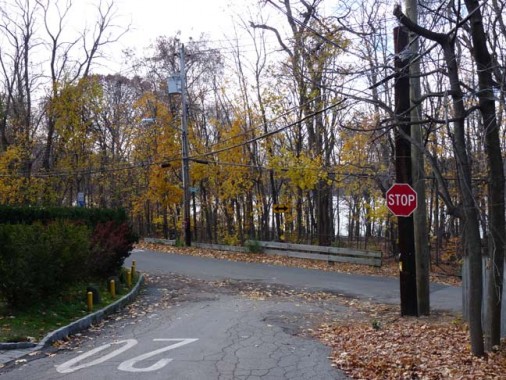
“You’d never believe you’re in NYC.” West 247th finally ends at Palisade Avenue, which parallels the Metro-North railroad. Some maps say it’s continuous from Spuyten Duyvil to Mt. Saint Vincents, but in Riverdale, that’s hardly the case.
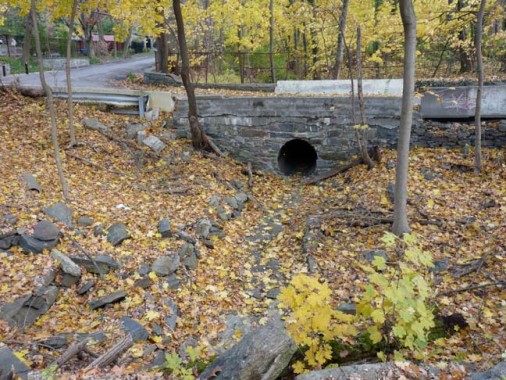
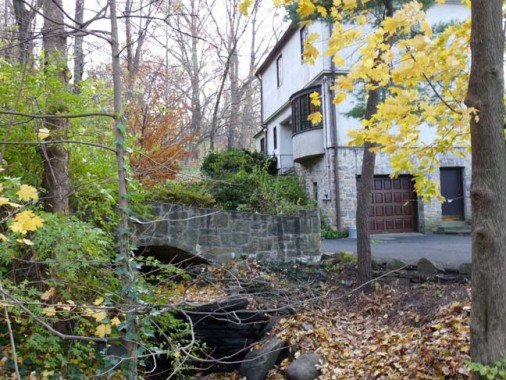
Alder Brook parallels Spaulding Lane and empties into the Hudson River near the Riverdale Day School. Its route was recently restored. Along Spaulding Lane, some driveways are bridged over the brook. I was surprised to see this because I’d only seen this arrangement before in Baxter Estates, near where I used to work in Port Washington, Nassau County.
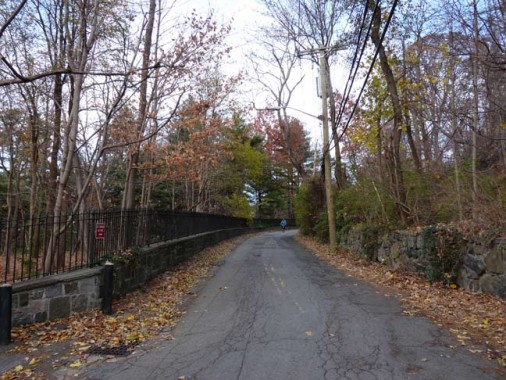
Independence Avenue resumes yet again at Spaulding Lane and runs in a lengthy section ending at West 254th.
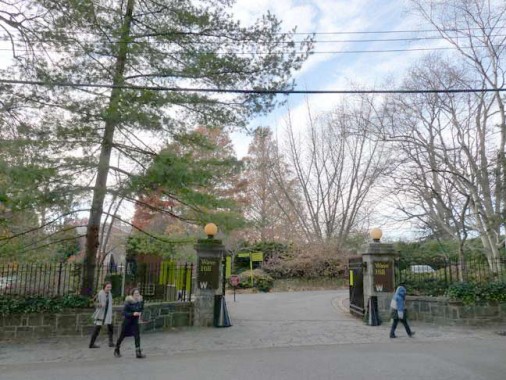
As far as the public is concerned, Wave Hill, Independence Avenue and West 249th, is likely the Riverdale locale that is best known. Surpringly hard to approach (West 249th is really the only east-west street that reaches it, causing motorists, bicyclists and hikers to jam the narrow, potholed path)…is officially known as the Wave Hill Center for Environmental Studies, but is really Bronx’ second botanic garden (the first being in Bronx Park) and a relaxing rural retreat 45 minutes from Times Square by subway and foot. The mansion (also known as Wave Hill) was built by William Lewis Morris in 1844 and expanded by subsequent owners. After conservationist George Walbridge Perkins bought the estate, he built the nearby Glyndor mansion, also on the Wave Hill grounds, and rented the older building to guests like Theodore Roosevelt and Mark Twain.
Wave Hill is open year round; admission for adults is $8.00, less for kids and seniors.
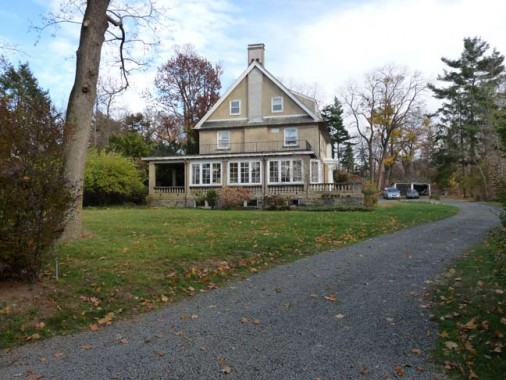
5000 Independence Avenue, with a huge front lawn.
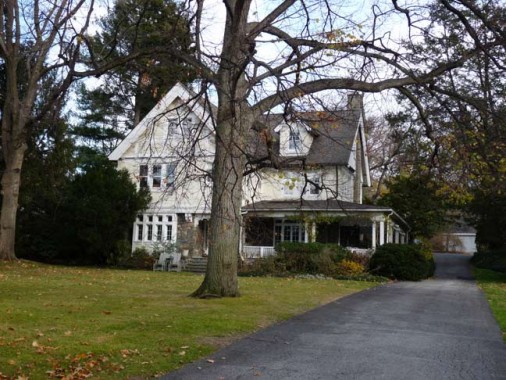
5020 Independence–with that shady front porch, who needs air conditioning?
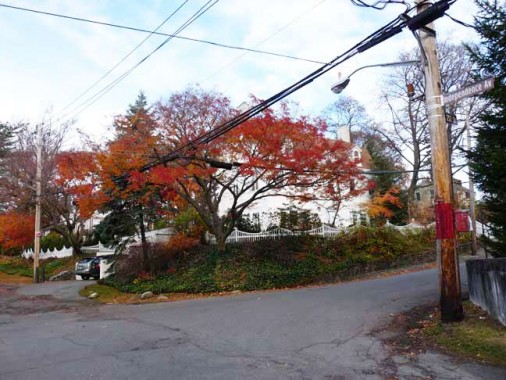
Seasonal coloring at West 252nd and Independence Avenue.
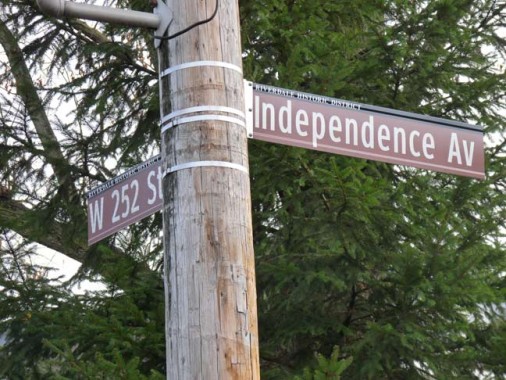
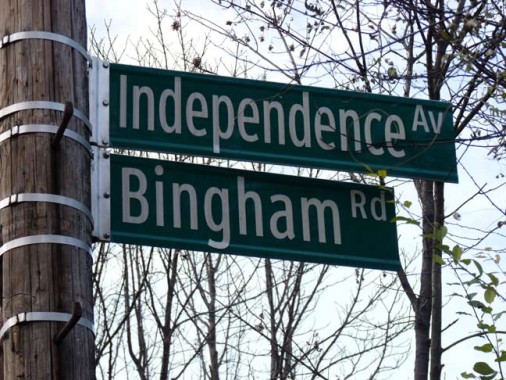
The maroon signs indicate the presence of a NYC Landmarks Historic District. The Bingham Road sign was added to the one block of Independence Avenue between West 252nd and 254th in 1989 in honor of the late Congressman Jonathan B. Bingham (1914-1986).
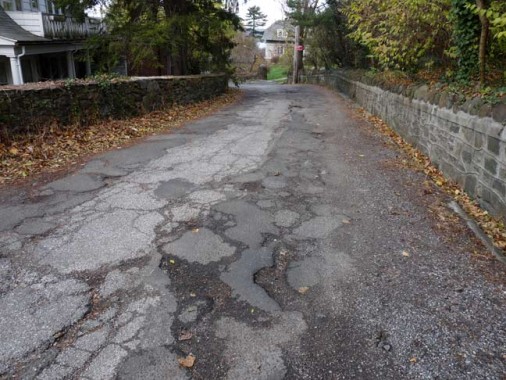
Most Riverdale streets are not paved very well, but Sycamore Avenue, which runs from West 252nd to 254th north of Wave Hill, takes the booby prize. I have heard it surmised that the well heeled Riverdalians actually cultivate such potholes (as well as the map errors) because the unwashed hoi polloi in their SUVs and trucks would invade these secluded paths if the streets were ever scraped and paved.
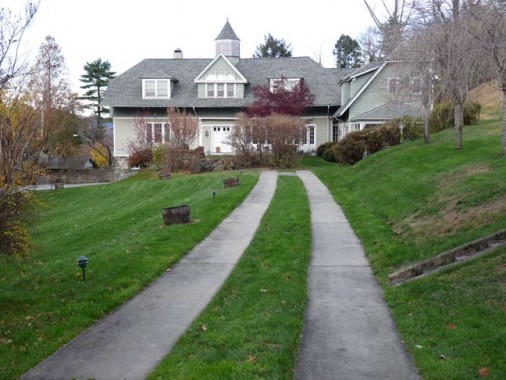
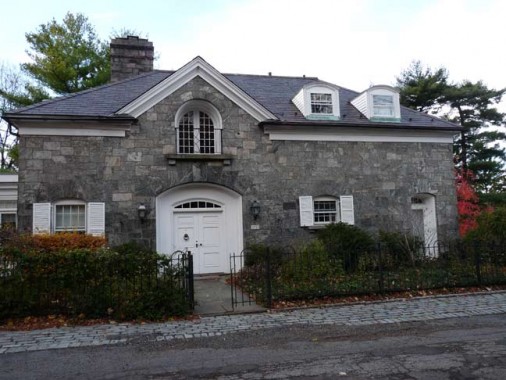
5220 and 5253 Sycamore Avenue.
Periodically I check in at West 254th and Palisade Avenue to see if NYC’s oldest telephone pole mast lamp is still there. The streets of NYC used to be filled with these simple rods supported by a piece of metal scrollwork – there were thousands of them. This one is the only one still in active use. When it was installed sometime in the 1910s it supported an incandescent lamp, likely a radial wave. It also supported a fire alarm inidicator light: the masts that had those lamps had the scrollwork at the top, like this one. The ones without the alarm indicator had the scrollwork at the bottom.
This one has survived likely because it’s now in the midst of some tree limbs and would be a pain in the neck to remove! DOT… save this lamp.
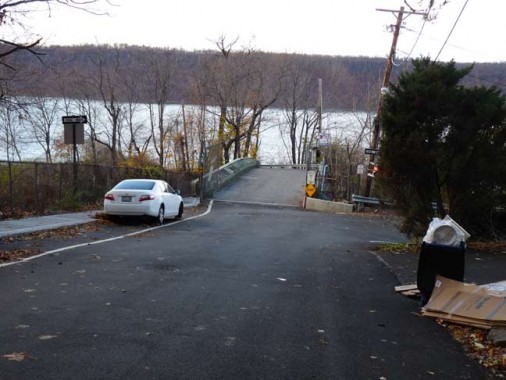
Finally…an unobstructed view of the Hudson River and NJ palisades. West 254th bridges over the railroad to a parking area.
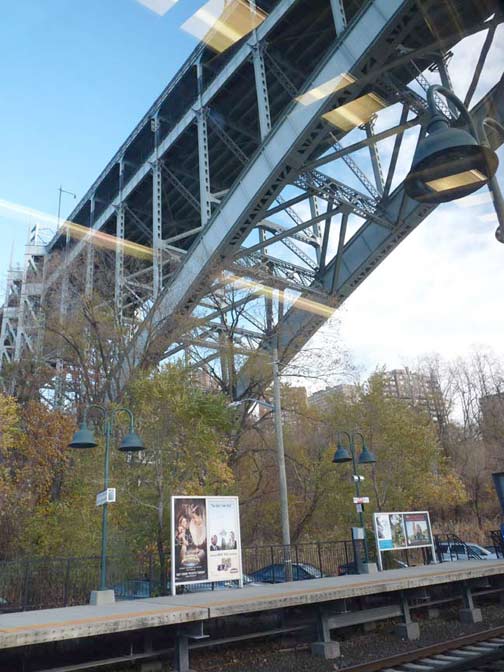
I got to Riverdale station just in time to catch the train back to Grand Central — very unusual for me. I shot the platform at Spuyten Duyvil out the train window. The magnificent Henry Hudson Bridge spans over the platform.
11/24/13


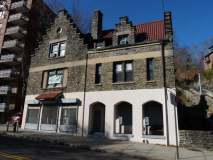

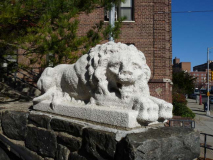
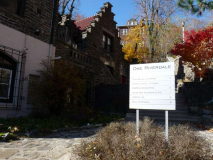
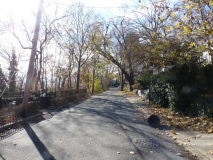


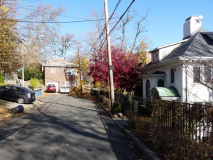
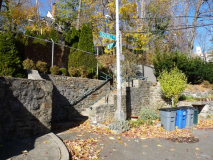


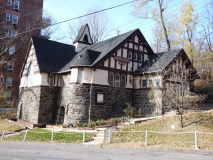
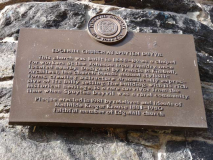
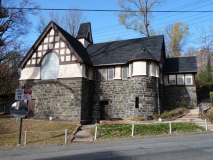
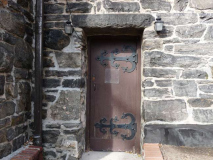
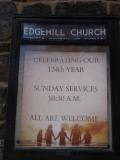
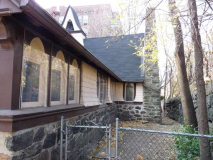


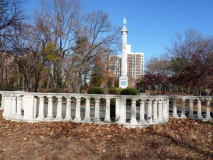
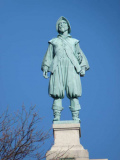
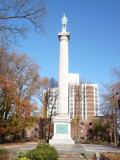
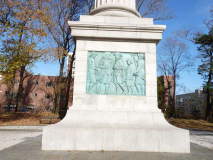
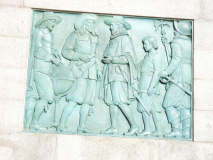

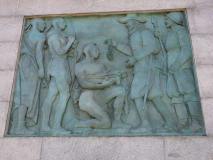


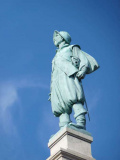
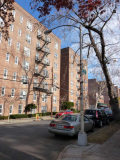
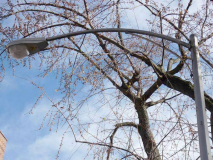
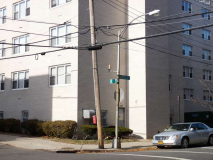
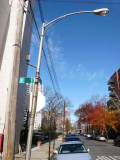
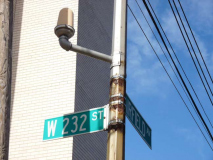

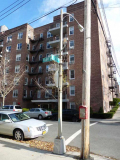
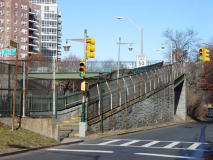
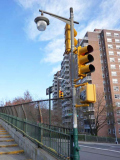

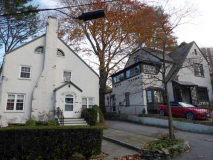
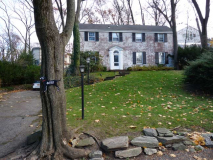

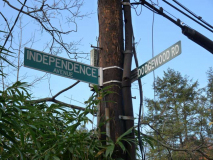
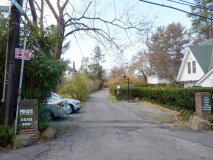

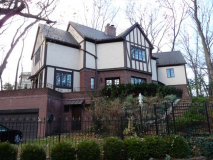

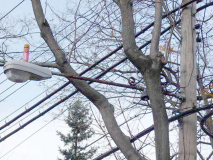

82 comments
AWESOME COVERAGE! I’m so glad to see my neighborhood covered! We are Bronx proud! Contact me, I’ll show all the cool places to hang out when you’re in Riverdale!
Some really gorgeous homes up there. The typography is SO different from Brooklyn, at least where I am in Brooklyn. Kinda flat. Forest Park is the closest we have to the Bronx rocky cliffs. Where Riverdale ends and Yonkers begins is such a maze to get through. Great posting!!
As an admitted provincial I am utterly astonished (and a little sad) at the sight of those massive apartment structures. Efficient, maybe, but not what I would consider welcoming.
Loved the tour Kevin. Riverdale has always been one of my most favorite neighborhoods in New York City and I loved the interesting historical tidbits you provided here. I usually don’t like the juxtaposition of urban and semi-rural settings (huge apartment complexes almost on top of country like cottages, to estate properties), but it just somehow works well in Riverdale and doesn’t detract from it’s charm. I’m sure the abundance of greenery and hills and river views help to soften the dichotomy here, and I just never tire of seeing Riverdale. It’s just clearly a special place.
That original Bishop’s Crook on Broadway outside the steakhouse harks back to an earlier incarnation of that establishment, Donaghy’s, which is what the restaurant was called back in the 1950’s/60’s (and undoubtedly long before, but not to my personal knowledge), when the Kingsbridge area was more monolithically an Irish neighborhood; it’s now a mixed neighborhood of many European-American ethnicities and many Latin-American ones, much like Inwood, its neighbor to the south across the Harlem River. Donaghy’s was an old-fashioned fairly-lace-curtain-Irish drinking-establishment-cum-sit-down-restaurant, and having that post outside fit the theme; I’m sure the landmarking of it went back to the days of Charlie Buckley, Congressman and Dem boss of The Bronx in the mid 20th C.; surely Charlie Buckley could not have been unfamiliar with that fine establishment.
(By the way, though you believed the spire on the St John’s Church might be Art Deco, it only dates back to the late 60’s, in fact. Deco in-“spire”-d, perhaps (*boom tish!*), but not of that era.)
“I’m sure the landmarking of it went back to the days of Charlie Buckley.” That is impossible. Charles Buckley died in 1967. The street lamps, such as this one, were not designated until thirty years later in 1997.
This post (indeed, all your posts) are astonishing and wonderful. I am a regular reader. Thanks a thousand times!
[…] PHOTOS [Ephemeral New York] 5. Bronx’s Riverdale nabe has NYC’s longest staircase: PHOTOS [Forgotten NY] 6. Brooklyners call for greater accountability at Atlantic Yards [Atlantic Yards […]
Kevin,
I really appreciated this lengthy stroll through an area of the Bronx that is adjacent to my neighborhood of Inwood, separated only by the Harlem River. I have wandered over the Broadway or Henry Hudson Bridges many hundreds of times and have criss-crossed all of the roads and stairways that you mention. I was a little surprised that you were so close to Villa Charlotte Bronte but did not mention it. One of the totally unexpected sights in the southern part of your trek and as unique as the Edgehill Church with its Tiffany windows on the other side of Henry Hudson Park.
Since you eventually passed by and made note of Wave Hill, I thought I’d send this link to an article in last week’s NY Times that went into the time that a young JFK lived in a house across the street from it (a link to a photo of the house, 5040 Independence Avenue, is within the article).
Again, I really loved the extent of your coverage that included the mundane and the exceptional in great detail.
It looks like you strip out links, but I’m sure anyone interested what I linked to could probably do their own search and turn up info on the Villa (look for a link to Lehmann College’s Bronx architecture site and avoid all the real estate listings if you can) and JFK’s childhood home.
Nice tour of a good part of my jogging path. I never noticed the rare lampposts we have in Riverdale, but I’ll be looking now. It’s hard to keep from wondering, as one sees these mammoth homes, what the occupants do to afford to live there. Still, Riverdale is a neighborhood of lovely streets, and it’s a good place to go home to after a busy workday in Manhattan.
Very enjoyable tour of Riverdale. When I was a little girl my family lived here for a few years, I’ll have to ask my parents what address. I do remember the staircases.
My father tells me that we lived in Marble Hill. This was in the late 1950s.
Thanks for the tour. Lived briefly in Riverdale in the early 1970s and this brought back a lot of memories. It also taught me about parts of the neighborhood I never saw.
I’m intrigued: “Store your cell”? A place where workers who aren’t supposed to have cell phones during the job hours can leave them?
I think it is meant for the students at Kennedy High School which is nearby.
Kids can’t take cell phones into school. some are stricter than others, but there has been a proliferation food carts and others who will take the childs phone for a buck a day…
Store Your Cell was for the students at JFK HS down the block. They are not allowed to have cellphones in the building. For a fee of about $1/day, they could store their cells at this location.
Crazy!
The building with the R crossed with T (3103 Fairfield Avenue) is called Riverdale Towers, although Eleanor Roosevelt is reported to have visited it, so maybe she thought it was named for Teddy, also.
Excellent piece and nice pictures. I lived in Riverdale for close to 3 years at the turn of the millenium and those pictures brought back some memories.
I grew up in Riverdale off Independence Avenue so a nice stroll down memory lane. Thanks. As a teen when Columbia University owned the Dodge Mansion they used to have chimp studies ( the Nim Project for which there is a documentary) there and there were some times that the chimp was at the fence of the nursery school I worked in during summers. Dodge Hill was one of our favorite sunbathing spots…
Right across from Wave Hill was a house that Joe Kennedy (John and Bobby’s father) and family lived in for a few brief years before moving to Bronxville.House sat abandoned for many years, not sure if its still there or was torn down and rebuilt.
See my post above. As I said, there was an article in the NY Times the week of the JFK assassination 50th anniversary that went into a fair amount of detail about the Kennedy’s stay in Riverdale. The house at 5040 Independence Avenue is still standing, though it doesn’t seem to be occupied at the present time. You can still look this article up by searching “Kennedy Riverdale” on the Times’ site.
Still there
For a year, while the Kennedys lived in Riverdale, legend has it that John F. Kennedy was a member of Boy Scout Troop 240, which met–and still meets–at the Riverdale Presbyterian Church; designed by the same architect, James Renwick, Jr., who designed the Dodge’s Greyston Gatehouse Estate (and St. Patrick’s Cathedral; see the comment from Phil Gilson, below). My two brothers and I were also members of Troop 240 ca. 1965-75. When Bobby Kennedy was running for office (I think for the US Senate) he stopped on Johnson Avenue for a rally. My mother, Millie, went to see him with my younger brother, Robert, who was about 5 or 6 at the time. With the crush of the crowd, Bobby saw my mom having trouble protecting her son, so Bobby picked him up and put him on the hood of a nearby car for safety. BTW, Greystone Ave, where I grew up (@ 238th St), is named for that Dodge estate. An “e” was added to Greyston. My brother, Robert, would become a groundskeeper/landscaper at the Fieldston School for about 30 years until about 2010.
loved your post , i grew up in manor terrace , on the west side of the building with the most amazing views of the hudson, fun to see some of the small streets and spots i remember, growing up in that section of Riverdale was like a bunch of small secret places always finding new spots , made it feel like you were the first ones to discover them, very special topography
Thank you for a super story and pictures of where I spent 15 years raising a family.
Maybe I missed it, but did you mention the Charlotte Bronte villas on Palisade Ave? Worth visiting for their architecture and beauty.
Though it wasn’t pointed out in Kevin’s article, I commented on this above. Anyone who wants to see an assortment of photos of this unbelievable enclave should go to the Lehmann College Bronx architecture web page and find the link to Villa Charlotte Bronte. The pictures were all taken in a season where the trees were in full leaf and blanketing everything in deep shade and are actually pretty poor, but there is quite a bit of information about the history of the Villa. Several real estate brokers are currently listing one of the units for sale and have more flattering pictures and some typical fluff describing it.
The site also has plenty of other info about neighborhoods and specific architectural wonders of the Bronx.
Thanks for the stroll through memory lane- my dad’s house is even pictured here! Nice to see some familiar spots from my childhood.
Good work!
Great post – I grew up in Marble Hill in the 70’s, and I can tell you that we considered ourselves Bronxites – so far as I was always taught, the dividing line between the Bronx and Manhattan was the Broadway Bridge.
Wonderful job, as always. As a complete aside, the US9A signs on the Henry Hudson service road are erroneous. They should be NY9A signs. As a roadbuff, that always bothered me.
What he—^ said.
Beautiful photos of a picturesque area. I was wondering: If some of the houses on the 230th Street step street have their entrances off the steps, does this mean that the postperson has to climb the steps to deliver the mail every day?
Nice pics-thanks for the memories of the Bronx!
I believe the house to the left of the staircase was once the home of Artuto Toscannini. My grandparents owned a candy store on 231 street between Kingsbridge Avenue and Godwin Terrace. Many celebrities stopped by to pick up newspapers on their way back to Riverdale. One of their favorites was Chang Hi Sheck.
There were four candy stores on W. 231st St. Two on each side. Yours was called Conn’s or Kahn’s I believe. Leitner’s was above you closer to Kingsbridge Ave.
In the 60′ the 4 names of the candy stores were south side near Broadway Al’s and Murray. North side near the Godwin steps was called Moe’s &molly’s. west o Godwin Terrace there was Paula’s on the north side just before Kindgsbridge Ave and on the south side was Joe’s
According to a biography by Mortimer Frank, Toscanini lived in two Riverdale locations. The earlier one that is most well known is Wave Hill. His home there is now the main building of this public garden and cultural center. After this, he moved to Villa Pauline, which I cannot precisely locate, but it definitely was on Independence Ave. somewhere in the vicinity of 248th St. This is where he died. Neither of these locations are particularly close this particular staircase. It may be that some member of the family lived in the house you mention. In my nearby neighborhood, Inwood, there is a house that old timers call the Houdini house because legend has it that he lived there. The reality is that one of his aunts lived in a different house a couple of blocks away, but that was enough to get the legend going. I think this might be a similar case.
The Toscanini family first rented Villa Pauline, at 655 W.254th St, from 1939-41, then rented Wave Hill until 1945. Villa Pauline was purchased by Toscanini in 1946 and he lived there until his death in 1957. His son Walter remained in the property until his own death in 1971. It was sold to school developers in 1974 then recklessly torn-down in 1980. The 28 room mansion was one of the finest estates, not just in Riverdale, but in all of New York City.
Kevin,
If anyone is interested, here is a download link to a zip file containing some photos of Villa Pauline – and an architecture report by the Riverdale Nature Preservancy in 1998. The aerial shots of the villa were taken in June 1951. The rear gardens sloped steeply down to the railroad line and river. You can see how undeveloped NW Riverdale was back then – a real haven of peace and tranquility. Toscanini purchased the estate for over $100,000 in 1946 – an fortune back then. Wave Hill was valued in the 1940 census at $75,000 – again, a fortune.
http://www.mediafire.com/download/85aby8dg7u94kg5/Villa+Pauline+655+W.254th+St..zip
Hi Alan,
Just read this article today (6/18/2021).
Hope you are well!
Jeffrey’s friend Willy (120 West 228 St.)
You covered it all, I moved away more than 10 years ago and this brings me back,
Thanks
I left Riverdale in 1968 after getting married and moving to LA and then on to Ireland.
I really enjoyed your article. Very nostalgic and well written.
Thanks
Thank you so much for your wonderful piece.I grew up in riverdale in tne fifties and sixties and roamed far and wide.I am still horrified at lack of zoning which allowed huge apt houses to be built anywhere amongst private homes.Ugly.
I remember Alderbrook and a regular weekend job in a gothic like mansion owned by Mrs Elie Nadelman.She was the elderly widow of tne artist.
It was a bit creepy being filled by large scultures sitting about.I often had to sleep there on horse hair mattress.And help when she entertained Lincoln Kirsten and Mrs Paley.
We walked everywhere and it was our playground.That long long staircase was our path to broadway and tne train to Music and Art high school.If we had a bus pass ( fare was ten cents) we could avoid those stairs.Tons of books in those days.The shelvan bakery had great linzer tarts for energy!
Cry Terror, a1958 movie with James Mason and Inger Stevens. Mason has to race to Kappock St. to rescue his kidnapped daughter, was it?
What a great tour you gave! Let me know if you plan to do a walking tour? I would love to go!!
I came across your Riverdale posting with its photo of the Spuyten Duyvil train station today when a very bad derailment had occurred just north of the Spuyten Duyvil train station.
http://www.nytimes.com/2013/12/02/nyregion/metro-north-derailment.html?hp
Wonderful tour. Grew up in the Marble Hill Houses in the 50s and 60s. Aspiring to live in Riverdale was big. Toured all these streets on my Raleigh 3 speed. My brain is so nostalgic now after your tour. Remember the day the G. Washington plague was put up on building 12. I never was in Henry Hudson Park or the newer Raul Wallenberg Forest. time for my own new tour . Thank you so much.
What a wonderful tour! My family grew up in Marble Hill too. My brothers were born in 1950, 1952, 1956 and I in 1961… I believe Tony Curtis grew up there also. My mom’s mom and his mom were friends. My mom tells one story of Tony (then Bernie Schwartz) when he was in the army, and his mother would come and sit in my mother’s mom’s apartment at designated times to receive a telephone call from him, because his mom was too poor to have a phone in her apartment. Shortly after I was born in 1961, we moved to a house on Murdock Avenue in the NE Bronx, near Seton Falls Park, because our family got too big for our projects’ apartment. And then when I was in 6th grade, we moved to a house in Riverdale at the bottom of the hill at the mid-point of the two Edgehill Avenues… I walked those giant stairs many times 🙂 I was just telling someone about those stairs at a Thanksgiving dinner! What a treat to see these photos and read the tour. I loved living in Riverdale. I loved Edgehill Avenue’s quirky quaintness. I loved the hills and going to JHS 141 and all the friends I made there, and the “upgraded” different life from the NE Bronx. We had “departmentalized” classes at JHS 141! And I was on the track team with my athletic crew of girlfriends. And we took languages! Spanish, French, German. And our house had a big lawn with a giant maple tree, an outdoor stone patio, and beautiful landscaped flowers. And a fireplace in the living room! I loved that. We used it a good bit even though it got freezing in the rest of the house when we did 🙂 I had my sweet sixteen on our lawn with the chimp “Mr. Jigg’s” as the entertainment. How cool is that. I remember my big cork platform sandals holding up my skinny long legs, feeling so special on that day. My mom was so wonderfully creative as a mom. And the big bright yellow and orange modern kitchen I loved coming home to after school, and making myself a bowl of Chef Boy-Ar-Dee beef macaroni. (The days of eating whatever in blissful oblivion!) The dining room’s tasteful italian style burnt orange-ish colored tiles. A cool pool table in the basement where my brother built his amazing carpentry shop. The giant white rose bush outside my window and how it changed with the seasons. The attic that we finished with two bedrooms and a shower bathroom for my two brothers. And how my carpentry skilled brother hand paneled his room, and built an arch and custom built-in dressers and a secret passageway in the closet, and his bed on rollers that pushed away out of sight under the eave. Our two cats, a mom and daughter, and our 90 lb. silver sable german shephard – who lived a good life with us and died of old age there in the hallway, in my arms, when I arrived home from school one day. Our two cats too died while there, as did my precious talented skilled brother at the age of 27 in the garage in car with a stuffed tale pipe on that tragic February 19th in 1980; the same year my parents finally sold the house in a down market, and my mother left my dad. I and my other two brothers were living elsewhere. I went back recently because two dear friends lives in the Century apartment building that abuts my family’s old big lawn. It was a crisp sunny day, and a delight to show my friend my childhood home. Bittersweet, oh yes… but both the bitter and the sweet tasted alive; and I could feel gratitude because I could feel the heartache. I could feel the heart and the ache, the love and the pain. Most of the my life, I had been mostly numb. But that day last year, sharing my visit home to the house on Edgehill Avenue, I took all of it in. Before I left, I knelt and touched the grass on the lawn where my two cats lay buried, where the commemorative stone carved by my now also dead brother, would have been; and I let all the memories, and all the love permeate my body. And it was ok. We all did what we could. And I’m ok.
What a wonderful tour! My family grew up in Marble Hill too. My brothers were born in 1950, 1952, 1956 and I in 1961… Tony Curtis (then Bernie Schwartz) grew up there also… his mom and my mom’s mom were friends. Shortly after I was born in 1961, we moved to a house on Murdock Avenue in the NE Bronx, near Seton Falls Park, because our family got too big for our projects’ apartment. And then when I was in 6th grade, we moved to a house in Riverdale at the bottom of the hill at the mid-point of the two Edgehill Avenues… I walked those giant stairs many times 🙂 I was just telling someone about those stairs at a Thanksgiving dinner! What a treat to see these photos and read the tour. I loved living in Riverdale. And I loved Edgehill Avenue’s quirky quaintness.
This 2nd one is the shortened version.. because I didn’t think the first one took. Moderate as you see fit. Thanks!
Did St. John’s Church always have that spire atop the bell tower. I lived on Kingsbridge Ave. for 26 years and it somehow looks different.
I see the question of the spire has already been answered, that it was added in the late sixties. I also remember that the church was built with smooth white brick and sometime in the late 50’s or early sixties someone thought that it would look better with a rough look so the entire surface was hammered away for a distressed look. Both the spire and the distressing did little to improve on the original architect’s plan.
I was born in the Bronx in 1946 and lived there until 1967. Ilived in the HIghbridge section but rode my bike in Riverdale . I was always impressed with the large old homes in Riverdale. When I was very young I could not understand why the people from Riverdale did not indicate that they were from The Bronx. Now I now know why.If I ever had to move back to the Bronx(from NJ) I would only live in Riverdale.
shocked you missed my building! art deco built in 1929 and hotel to presidents and celebrities before becoming one of the oldest, if not the oldest large establishment in Riverdale complete with stacked stone carriage houses and fire towers. Hudson Gardens.
“…architect James Renwick, Jr. ” -He also did St Patrick’s Cathedral (50th St and 5th Ave) . He has a stained glass window (on the 50th St side entrance) depicting him discussing the plans with the hierarchy.
Great tour of Spuyten Duyvil and Riverdale! The plaque on Edgehill Church bears the name of one of my great aunts, Tillie Kroger Krause, who was born, along with my grandmother and seven other siblings, in a large house that stood at the corner of Pallisade Avenue and E. 231st St. The house was owned by my great grandfather, Henry Kroger, who had a wine and liquor importing business in Greenwich Village until Prohibition changed his business plans! One of his sons-in-laws was a well-known architect, Anton Korn, who designed many of the tudors in the area and many of which still stand.
Having taught there many years ago, I was looking for Fieldston School. I don’t know who originally owned the tract of land, and would be curious as to any history.
Maybe next tour?
MY FIRST MEMORIES WERE LOOKING AT THE PALASAIDS OUT OF OUR KITCHEN WINDOW IN THE 1940’S. WE LIVED ON THE TOP FLOOR OF A THREE STORY HOUSE THAT WAS BUILT FOR THE WORKERS OF THE DOUGLAS ESTATE NEAR 239TH STREET AND INDEPENDENCE
ST.
THE OPERATIVE ESTATE WAS BY THEN INOPERATIVE AND LEFT US WITH AN EMPTY FARM LAND THAT WE CHILDREN C0NVERTED TO OUR BASEBALL FIELD. WE LIVED IN PARADISE.
WE ROAMED THE ESTATE AND THE DOUGLAS ESTATE, THAT WAS BY THEN ABANDONED.
MY HEART HAS NEVER LEFT THAT PARADISE. THERE WERE FIELDS, GARDE PLOWS AND SICKLES. IT WAS AS IF TIME STOOD STILL AND LET US YOUNGER CHILDREN GET A GLIMPSE OF THE PAST.
I STILL ROAM THOSE FIELDS IN MY MIND. THANK YOU FOR BRINGING BACK TO THE PUBLIC SOMETHING THAT CAN NEVER IMAGINE.
JOSEPH LAHIFF
Thank you for not letting these glimpses of the past be forgotten. Since my daughter now lives I. Riverdale, some of these sites are familiar; others are destinations yet to be discovered when I visit.
Forgotten really ? anyone in new york knows how people flock to riverdale it’s considered the best place to live new york except for Manhattan politicians, directors ,some of the richest in new york live here.
I must be interpreting this in some wrong way but riverdale is well known and tell me why someone has to pay $8.00 to walk on a mansions grounds seems strange when I found out they were making you pay to walk around a property I guess they make money from anything.I see everything pictured everyday not hidden to most .
I think the TR buildings you reference might stand for Riverdale Terrace. Just a guess.
While this is a great review of lots of Riverdale history, I was shocked to see the RIDICULOUS description of the RT on top of an apartment building on Fairfield Avenue. The name of the building is Riverdale Towers – thus RT! It’s NOT TR and it doesn’t refer to Theodore Roosevelt!!!
Well the letters are interlocked, only a local would know it’s RT not TR…
Great article. I recognized several of the homes around the Wave Hill area where my brother and I would do yard work jobs as 12 and 14 year old kids in the 80s. We would hike up with our rakes, and what other tools we could carry, from our apartment at 236 St. and Riverdale Avenue. Great memories!
I enjoyed this glimpse back into my childhood! I worked in the now defunct Bronx Prescription Center and walked up those long staircases home. All these photos are wonderful, bring back a lot of wonderful memories for me. Makes me proud to share with people who are so quick to dismiss the Bronx as a beautiful place to raise a family. Riverdale is really a hidden gem, I wouldn’t trade it for anything. I look forward to other articles and photos you have!!!! Thank you, this was more appreciated than you know.
Wonderful job. We moved to Riverdale (“the cornelian”), 3801 Hudson Manor Terrace , when I was 12. It was really “countrified” back then for a kid from the Grand Concourse. Loved those 10 years, moved in 1969.
I worked at Bronx Prescription 1986-1988. When DoD you work there?
This is really interesting stuff. I grew up in the Riverdale on Hudson Manor Terrace (3801 just like Marty Leiberman in the text directly above!) in the mid-60’s and moved to Kappock st in the late 60’s. And there is something at the entrance to Kappock (Kappock and Independence is it?), that has always fascinated me, a remnant of an uphill cobblestone lane that runs maybe 50-60 feet and then stops, clearly, a vestige from a long time ago.
I wonder if you have noticed it (hard to imagine that you haven’t considering how fine tuned your observations of the area are) and if so, what you might know about it. Thanks very much. And thanks for all the interesting information about these neighborhoods!
Grew up on Vinmont Road, that Private Street you mention in your other Riverdale walk. You should walk up there sometime. There is a row of houses built by Mr. Weinberg and the deeply wooded area between the road and the Henry Hudson Highway was also his land. In fact, he owned all the property between Fieldston Road and Mosholu Avenue, from W. 256th (where the Public Library is now), to the Highway. This included the woods that became the Russian Mission tower. Luckily I moved away before they built that monstrosity. But I grew up in 404 W. 255th Street, which was officially the mailing address for Vinmont Road. And I so miss that Road and those years, climbing trees and hanging out on the Road.
Will I get chased?
I loved your tour! It taught me so much about the neighborhood where I grew up. If you haven’t done this already, I’d be interested in the history of the “villas” on the west side of Henry Hudson Parkway near Kappock Street; the Vinmont Houses on West 255th Street and Mosholu Avenue, where I spent the first 6 years of my life; and the Fieldston Historic District. In the meantime, thank you for what you’ve shared with readers.
As someone who grew up in Kingsbridge back in the 1960s and into the ’70s, Riverdale was always a respite where you’d forget you were in such a massive metropolis. Beautiful place.
Hey, since you mentioned 1 Riverdale Avenue with its unique architecture and that rough-hewn stone, any idea as to its history? When was it built? Must be one of the older structures in the area.
1 Riverdale was built in the late 1800s. Originally a Dutch shipping bank. Probably the 1st large building on Riverdale Ave…thus the number. It have been told that it at one time housed offices for the O.S.S….the precursor to the CIA…and the notorious Grove Press which dared to publish “banned” books by people like Henry Miller and eventually succeeded in getting them UNbanned. Now mixed use…some artists, some business people, a yoga center…a wonderful example of old NYC still functioning.
Great memories. Lived in Riverdale for about 5 years. Blackstone Ave. and the Century Bldg.
Don’t see mt post. Lived in Riverdale.
I am trying to find out historical details about the house located at 3101 Henry Hudson Parkway, where I believe Tillie Kroger Krause also lived. If someone has a connection to Jim Baldwin above, I would appreciate if they could put me in touch with him.
Thank you-
Stephanie Coggins, Spuyten Duyvil
This was a delight to read and peruse. I grew up in the Bronx (1948-1966) and we lived at 231 W. 230th Street (the building at the corner of 230th Street and Godwin Terrace). Attended St. John’s Church and went to St John’s School. The remodeling of the Church occurred under Monsignor Stryker, who inflicted a decidedly modern affect to the building which had originally been more Gothic in design. It was quite a controversy at the time! Everyone knew that “our” side of 230th Street was part of the Bronx, while anything on the other side was part of Manhattan; even the telephone exchanges were different. On the Bronx side, the exchange was KIngsbridge, on the other, LOrraine. Thank you for this!
I recently took a picture of a house on Post Road (near
Broadway ) that might be older than the Van Cortlandt mansion in the local Van Cortlandt Park. The house is
seen on maps from the 1700’s. The Hadley House
5122 Post Road – maybe it can be designated a historic
landmark – it has fallen into disrepair & supposedly
there could be slaves buried on the property.
Hadley house is in FNY– do search function